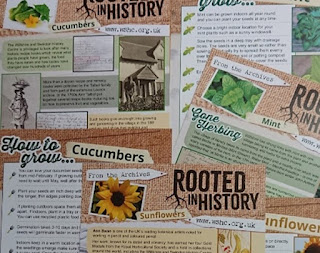Women and Community: From Archives to Action
Naomi Oakley, Archivist with Swindon and Wiltshire History Centre, describes the recent 'Rooted in History' project which used garden and nature-related archives to encourage people to garden. Naomi had arranged to present a paper on the subject at our last Annual Conference on Women and the Natural World: Historical
Perspectives on Nature Climate and Environmental Change, but was unfortunately prevented.
In 2022 the Wiltshire
& Swindon History Centre were awarded £10,000 through the National
Archives’ testbed fund (a fund to trial ideas) with the aim of using garden and
nature related archives to encourage physical activity, mental wellbeing, and to
get people gardening. The gardening theme also allowed us to further develop
our relationship with Rooted Chippenham, a community market garden founded by
two women in 2021 and which is based on the History Centre site.
One of the benefits of the ‘Rooted in History’ project has been the opportunity to delve into the wonderful variety of archives held here and discover more about women engaging with the natural world. Three leaflets were produced, each focusing on a different story or image from the archive on one side, with a small packet of seeds with growing tips for a plant linked to a part of the archive on the other.
Sunflower
The work of Ann Swan, one of the UK’s leading botanical artists living and working at Rowde in Wiltshire, was used for our ‘sunflower’ card. A collection of her work was acquired by WSHC through the Creative Wiltshire project which focussed on collecting and celebrating the work of the county’s creative people through a grant from the National Lottery Heritage Fund. Particularly noted for her work in graphite and coloured pencil, Ann has loved drawing since she was a child, while her love of gardening and plants came when she was almost forty and she began drawing flowers inspired by her ‘get well’ bouquets following a prolonged bout of illness. Her next subject was a cabbage after seeing a painting in a glossy magazine.
Ann developed a
method of using an alcohol-based solvent with layers of coloured pencil work to
achieve detail and depth of colour and reflect the life and vibrancy of the
plant, and is now a leading expert championing the use of pencil for botanical
art. The detail and vibrancy of Ann’s work is quite remarkable, and a fine
example of botanical art.
Mint
Herbs and
medicinal plants were of particular importance for the village of Sutton Benger
with ‘herbing’ (collecting herbs for sale to pharmaceutical companies) being an
important part of village life. In Life and Herbing in Sutton Benger:
Memories of a Wiltshire Village Nesta Heath records that the note ‘gone
herbing’ was to be found on nearly all doors in Sutton Benger on hot summer
days between the wars and up to around 1948. The practice of herbing began
through Nesta’s father’s first wife, Nanny Eccleston, who was the village school
mistress and a herbalist who taught the children about herbs and where to find
them. Her family home became the herb collecting point where they would be
brought and weighed. The workers would be given a chit to keep and then paid at
the end of the season to supplement their modest farming wages.
The herbs had to
be clean and dry and of good colour, and were often dried on tin roofs or
hanging over lines. Once one ton had been accumulated, a lorry would transport
the sacks to Chippenham railway station to be taken to London and Manchester,
particularly to the drug merchant Potter and Clarke, to be made into medicines.
 |
| WSHC P6048: Remains following a fire at herb stores, Sutton Benger c 1920-30 |
The work
contributed substantially to the local economy; Nesta’s mother negotiated
prices with the buyer from Manchester in March, and payment was made at the end
of the season with some people earning £100 or more, some as little as £2.
Cucumber
We have many
examples of recipes and remedies in the archives collected, recorded and shared
by women, evidence of the female role in treating family, friends and
neighbours for medical complaints as well as revealing what plants people have
grown, food they have eaten and how tastes have changed.
Recipes for
pickled and preserved produce were common, with pickled cucumber appearing
frequently. One recipe for preserving cucumbers involved twelve rather
long-winded processes over several days, with much boiling and simmering, as
well as adding considerable amount of ‘double refined’ sugar.
Various recipe and remedy books survive in the archives of the Talbot family of Lacock Abbey who owned it from the seventeenth century until 1944, when Matilda Talbot presented it to the National Trust. A recipe book inscribed as belonging to Ann Talbot 1742 includes ‘an excellent plaister for an ague’ from Miss Bromly, made with frankincense, vermilion (a powdered mineral pigment) and oil which should be heated over a gentle fire until melted and poured into a pot. The recipe specifies the plaster ‘must be in the shape of this paper and applied to the pit of the stomach’ hence the rather pleasing heart shape!
 |
| WSHC 2664/3/1K/11 |
The long tradition
of recording and sharing recipes is continued with recipe books of Women’s
Institutes. Secrets of Wiltshire Housewives is a book of recipes
compiled by Edith Olivier collected from members of Wiltshire Women’s
Institutes, most, as Edith Olivier notes in her preface, ‘in constant use and
many handed down in one family for generations’. Edith Olivier describes it as
a book ‘as full of good things as a Christmas pudding is full of plums and
containing not only a guide to a good dinner but cures for some of the ills
which afterwards attacks him who has dined not wisely but too well’. She
particularly highlights an ‘attractive cure is the ointment made of primroses,
and bringing with the faint scent of spring; but the “infallible cure for
Pneumonia” which includes the body of a large spider, has not the same charm…
and I also thought I might be burnt as a witch if I published the “Cure for
Falling Sickness” beginning with the words “Take a man’s skull that has not
been above a year buried”…’
It has been a
delight as an archivist to see previously neglected histories and stories of women
revealed through archives, as well as seeing these stories inspire people to
get active and get growing today.
I am an Archivist working for Wiltshire Council at the Wiltshire and Swindon History Centre, the record office for Wiltshire and the Borough of Swindon. I have worked at WSHC since 2014, in my current role since 2019. Immediately prior to coming to Wiltshire Council I worked for the University of Oxford at the History of Science Museum (then called the Museum of the History of Science) as Researcher-Cataloguer. I studied History at the University of York, before studying for an MSc in Landscape, Environment and History at the University of Edinburgh, and a Postgraduate Diploma in Archives and Records Management at the University of Dundee.





Comments
Post a Comment